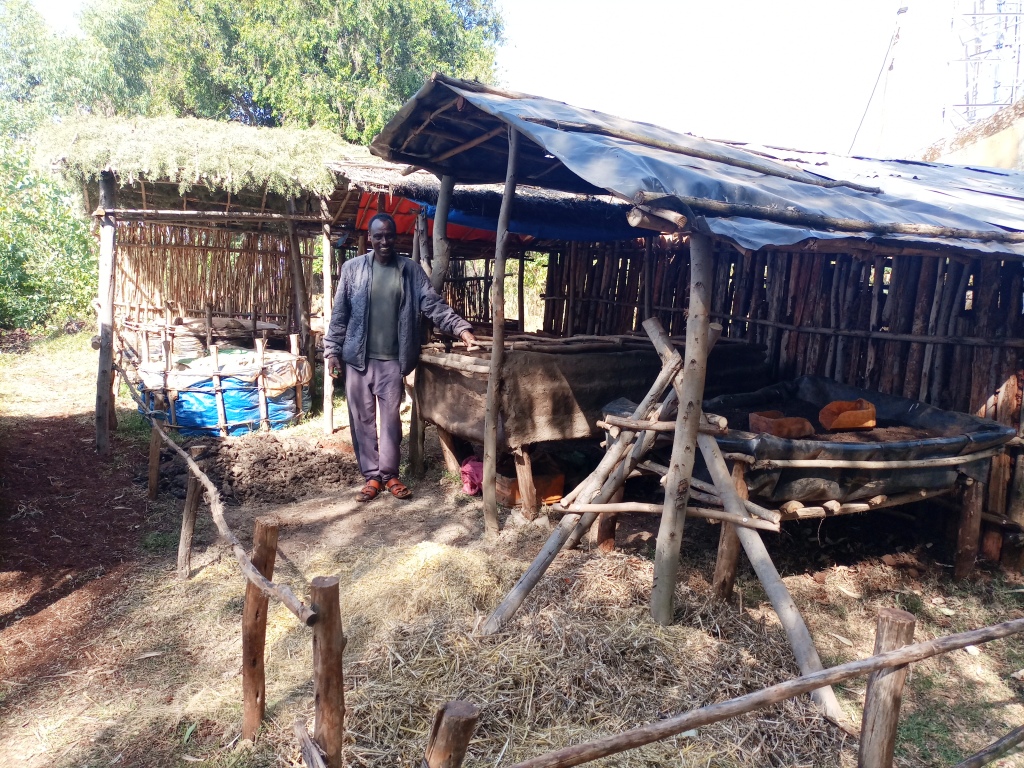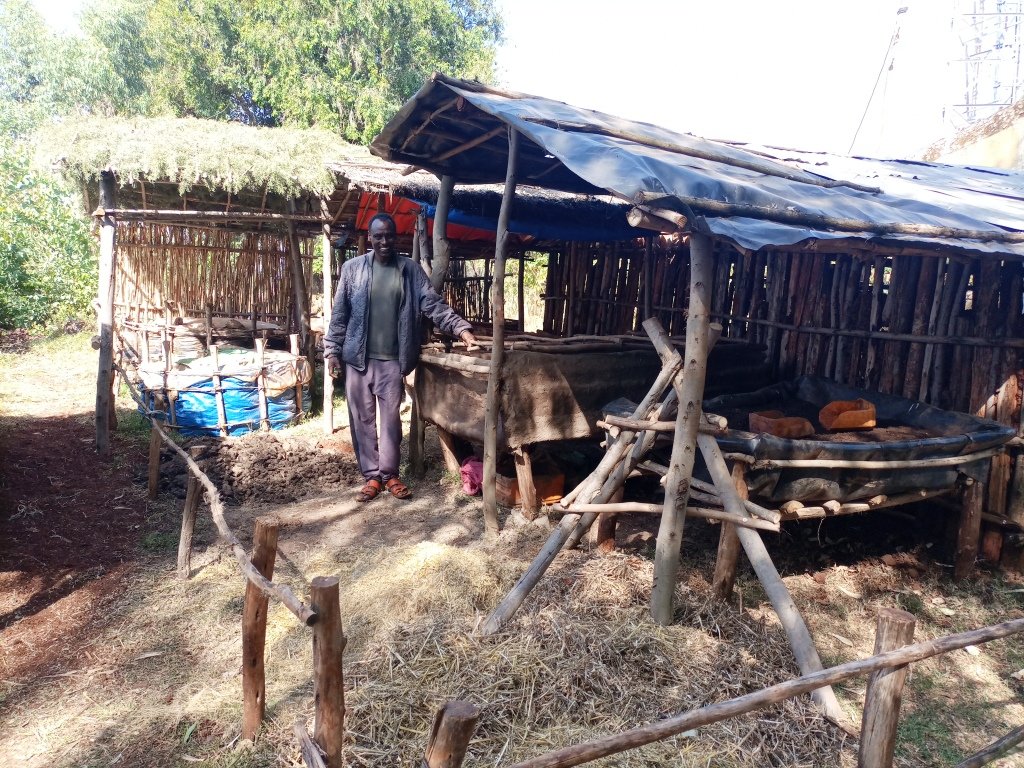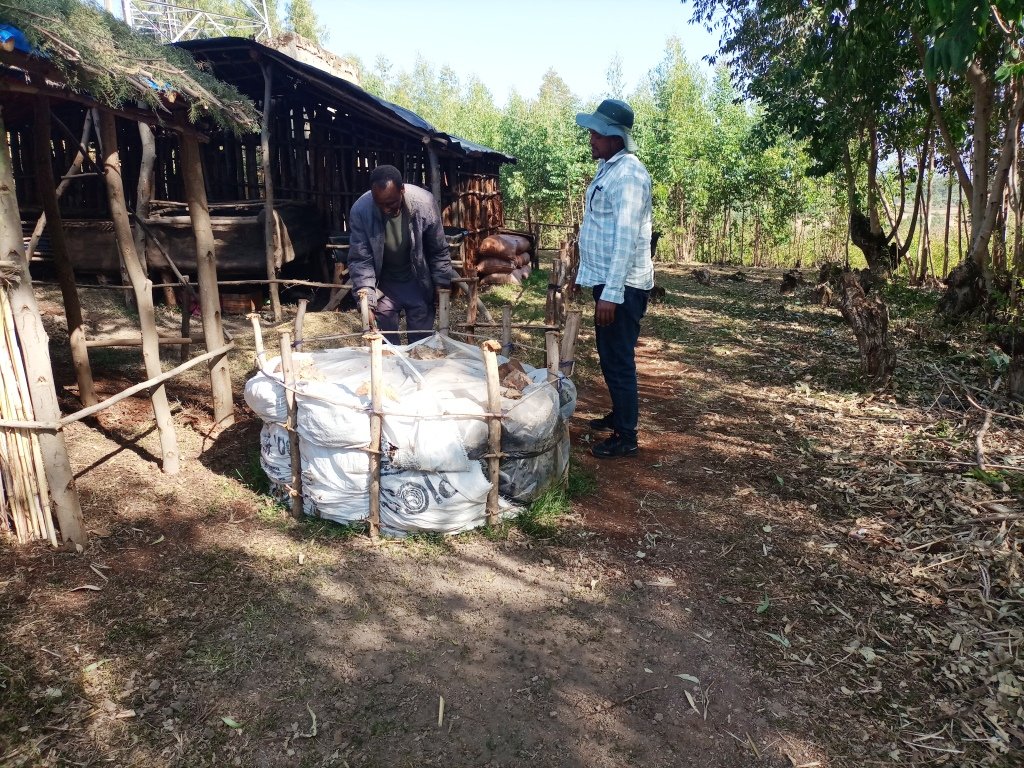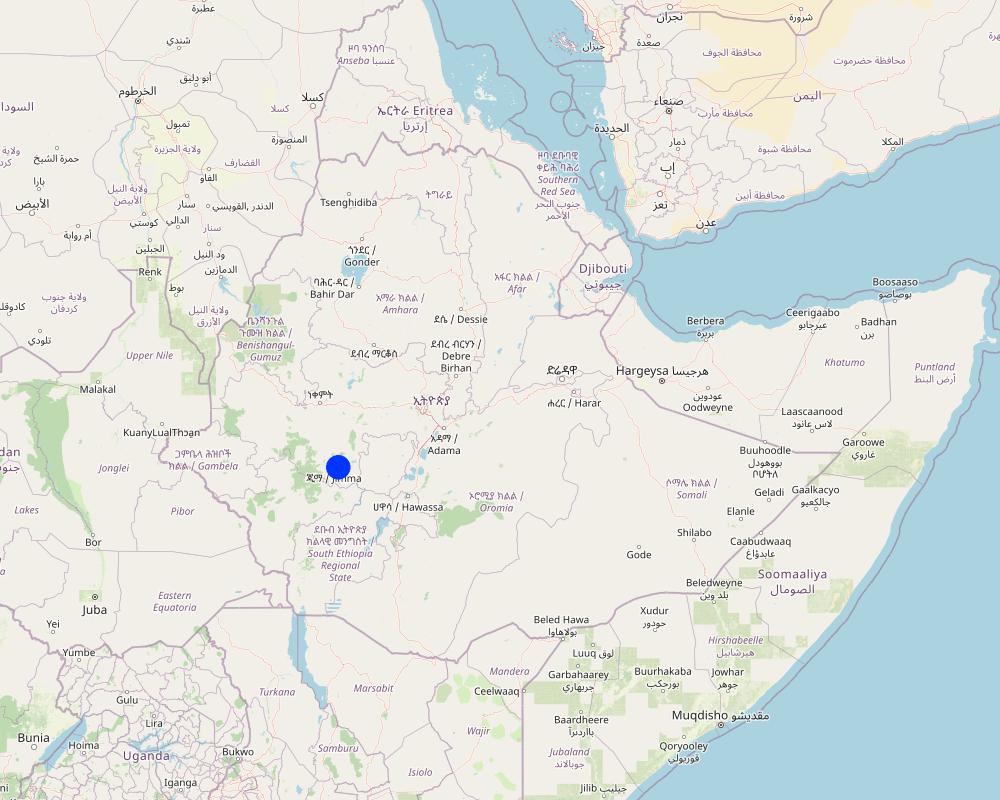Improved Compost [Ethiopia]
- Creation:
- Update:
- Compiler: GERBA LETA
- Editors: Noel Templer, Julia Doldt, Kidist Yilma, Tabitha Nekesa, Ahmadou Gaye, Siagbé Golli
- Reviewers: William Critchley, Rima Mekdaschi Studer, Sally Bunning
Kompoosti Fooyya'a
technologies_6649 - Ethiopia
View sections
Expand all Collapse all1. General information
1.2 Contact details of resource persons and institutions involved in the assessment and documentation of the Technology
Key resource person(s)
land user:
Abdulqadir Mohammed
Farmer
Ethiopia
Name of project which facilitated the documentation/ evaluation of the Technology (if relevant)
Soil protection and rehabilitation for food security (ProSo(i)l)Name of the institution(s) which facilitated the documentation/ evaluation of the Technology (if relevant)
CIAT International Center for Tropical Agriculture (CIAT International Center for Tropical Agriculture) - Kenya1.3 Conditions regarding the use of data documented through WOCAT
The compiler and key resource person(s) accept the conditions regarding the use of data documented through WOCAT:
Yes
1.4 Declaration on sustainability of the described Technology
Is the Technology described here problematic with regard to land degradation, so that it cannot be declared a sustainable land management technology?
No
Comments:
The technology is very friendly to SLM since it restores soil fertility and improves the chemical, physical and biological properties of the soil.
1.5 Reference to Questionnaire(s) on SLM Approaches (documented using WOCAT)
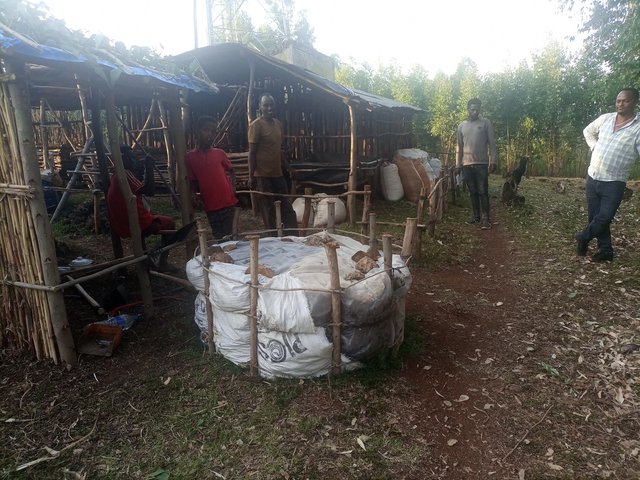
Soil Fertility Improvement Cluster [Ethiopia]
The Soil Fertility Improvement Cluster approach engages five or more farmers living in a village who share skills and labour to prepare and use improved compost as well as to demonstrate it to non-member of the group.
- Compiler: GERBA LETA
2. Description of the SLM Technology
2.1 Short description of the Technology
Definition of the Technology:
Improved compost making using “static pile” systems transforms organic material from plants and/or animals into high-value, rich organic compost. It demands less labour, and less time to reach maturity than conventional systems as it thoroughly mixes the ingredients at the beginning which precludes the need to turn the heap later.
2.2 Detailed description of the Technology
Description:
Improved composting using static pile systems transforms organic material from plants and/or animals into high-value, rich organic compost. This compost can be prepared in a heap form, where the ingredients are thoroughly mixed and wrapped within a polyethylene sheet. Notably, white polyethylene has the role of intercepting sunlight and improving the solarization effects on weed seeds or wild species arbitrarily used as biomass for improved compost production. This technique accelerates the breakdown of the organic materials faster because it heats up the compost as part of the decomposition process. Accordingly, the compost reaches maturity in 60-70 days. Compost provides the crop with balanced nutrients and helps to increase the soil's organic matter content. It has long‐term, and short‐term effects on plant nutrition as nutrients are continuously released. It is an organic matter resource with the unique ability to improve soils' chemical, physical and biological properties. Improved compost is applied in rows for vegetables and small cereal crops but spot application (planting holes) is employed for large cereal crops such as maize. The application is on an incremental basis year and again to reach out to the large size of lands. In principle, as the nutrients are slowly released, they may not need a continuous application like chemical fertilizers.
Improved compost-making requires 12-15 wooden pegs 1m high each supported by horizontal bars/string, to form a round structure. The interior is lined with plastic sheeting, then thoroughly mixed ingredients, including coffee hulls, ash, livestock manure, crop residues, livestock urine, water, and chaff are mixed and piled before being sealed in the structure. Unlike the mainstream heaps or pits types of composting, it doesn’t need turning. Therefore, this technique reduces labour requirement, and is liked by the users who have been piloting the technology. The relatively short maturity date also enables it to be produced at least twice a year during the offseason. Compost is prepared around the homestead – which allows closer attention - using livestock urine, manure, and house refuse.
In most of Ethiopia's central and western highlands, soil degradation is a severe issue. Soil acidity has become a growing problem challenging the livelihoods of smallholders. Thus, countering the negative effect of degradation and acidity through producing and using organic fertilizers is a key strategy. However, it is essential that the resources of biomass, family labour, skills and motivation, are combined to ensure sustainable land for crop production. From end users' observations and analysis, improved compost restores soil fertility. It increases yield as well as grain quality: this has been proved by testing the grain compared with the harvest where only chemical fertilizers have been applied. Farmers prefer the simplicity of preparing improved compost to the conventional method, and appreciate its role in improving yield and grain quality as well as reducing the labour demand.
2.3 Photos of the Technology
General remarks regarding photos:
The photo portrays the farmer measuring the total area (by cubic meters) where the improved compost is piled.
2.4 Videos of the Technology
Comments, short description:
Video of the technology is not recorded.
2.5 Country/ region/ locations where the Technology has been applied and which are covered by this assessment
Country:
Ethiopia
Region/ State/ Province:
Oromia
Further specification of location:
Babo kebele of Kersa district, Jimma zone
Specify the spread of the Technology:
- applied at specific points/ concentrated on a small area
Is/are the technology site(s) located in a permanently protected area?
No
Map
×2.6 Date of implementation
Indicate year of implementation:
2022
2.7 Introduction of the Technology
Specify how the Technology was introduced:
- through land users' innovation
- through projects/ external interventions
Comments (type of project, etc.):
Improved compost preparation was introduced by local NGOs known as FC Ethiopia that arranged experience exchange visits to a few farmers in the Arsi Zone of Oromia. A proactive farmer inspired by the technology outdid what he had observed during his visit. He continued inspiring the surrounding community by preparing improved compost with rich ingredients and early maturing capacity compared to conventional compost production.
3. Classification of the SLM Technology
3.1 Main purpose(s) of the Technology
- improve production
- reduce, prevent, restore land degradation
- conserve ecosystem
- preserve/ improve biodiversity
- create beneficial economic impact
3.2 Current land use type(s) where the Technology is applied
Land use mixed within the same land unit:
No

Cropland
- Annual cropping
- Perennial (non-woody) cropping
- Tree and shrub cropping
Annual cropping - Specify crops:
- cereals - wheat (spring)
- cereals - maize
- legumes and pulses - beans
- Hot pepper
Perennial (non-woody) cropping - Specify crops:
- banana/plantain/abaca
- sugar cane
Tree and shrub cropping - Specify crops:
- avocado
Number of growing seasons per year:
- 1
Is intercropping practiced?
Yes
If yes, specify which crops are intercropped:
Haricot beans with maize
Is crop rotation practiced?
Yes
If yes, specify:
Maize rotate by wheat and then faba beans.
3.3 Has land use changed due to the implementation of the Technology?
Has land use changed due to the implementation of the Technology?
- No (Continue with question 3.4)
3.4 Water supply
Water supply for the land on which the Technology is applied:
- rainfed
Comments:
Sources of water supply for improved compost making can be steams or groundwater. However, the compost can be applied to both the rainfed or irrigated agriculture.
3.5 SLM group to which the Technology belongs
- integrated crop-livestock management
- integrated soil fertility management
3.6 SLM measures comprising the Technology

agronomic measures
- A2: Organic matter/ soil fertility
- A3: Soil surface treatment
A3: Differentiate tillage systems:
A 3.3: Full tillage (< 30% soil cover)

management measures
- M2: Change of management/ intensity level
- M5: Control/ change of species composition
Comments:
Applying organic fertilizer to the farm stimulates the regeneration of the lost wild species on the farm.
3.7 Main types of land degradation addressed by the Technology

soil erosion by water
- Wt: loss of topsoil/ surface erosion

chemical soil deterioration
- Cn: fertility decline and reduced organic matter content (not caused by erosion)
- Ca: acidification

physical soil deterioration
- Ps: subsidence of organic soils, settling of soil

biological degradation
- Bc: reduction of vegetation cover
- Bh: loss of habitats
- Bs: quality and species composition/ diversity decline
- Bl: loss of soil life

water degradation
- Hs: change in quantity of surface water
- Hp: decline of surface water quality
3.8 Prevention, reduction, or restoration of land degradation
Specify the goal of the Technology with regard to land degradation:
- reduce land degradation
- restore/ rehabilitate severely degraded land
Comments:
The production and use of organic fertilizer improve soil fertility, regenerates lost species, and improve plant and animal biodiversity. Compost improves the vigorous growth of the crop, plant colour, and crop production. It also improves the rooting system, extends the grain filling period by about 20 days compared to the plot with chemical fertilizers, increases the number of ears/plants and seeds per ear in maize, etc.
4. Technical specifications, implementation activities, inputs, and costs
4.1 Technical drawing of the Technology
Technical specifications (related to technical drawing):
Picture that clearly describe the technology is affixed. Detail description is available under the description.
4.2 General information regarding the calculation of inputs and costs
Specify how costs and inputs were calculated:
- per Technology unit
Specify unit:
Compost production structure
Specify dimensions of unit (if relevant):
6-7m3
other/ national currency (specify):
ETB
If relevant, indicate exchange rate from USD to local currency (e.g. 1 USD = 79.9 Brazilian Real): 1 USD =:
53.12
Indicate average wage cost of hired labour per day:
100
4.3 Establishment activities
| Activity | Timing (season) | |
|---|---|---|
| 1. | Select site and constructing the structure. | During the off-season particularly right after harvest when adequate biomass is available. |
| 2. | Collecting ingredients for compost making. | During crop harvest |
| 3. | Thoroughly combine the ingredients and seal. | After materials are ready to make the heap. |
| 4. | Harvest/open and dry the compost on open air. | Six to seven weeks after piling the compost. |
4.4 Costs and inputs needed for establishment
| Specify input | Unit | Quantity | Costs per Unit | Total costs per input | % of costs borne by land users | |
|---|---|---|---|---|---|---|
| Labour | Labor | PDs | 5.0 | 100.0 | 500.0 | 100.0 |
| Equipment | Spade | number | 1.0 | 300.0 | 300.0 | |
| Equipment | Reck | number | 1.0 | 160.0 | 160.0 | 100.0 |
| Equipment | Machete | number | 1.0 | 1000.0 | 1000.0 | 100.0 |
| Equipment | Sickle | number | 1.0 | 500.0 | 500.0 | 100.0 |
| Construction material | Posts for peg making | number | 2.0 | 50.0 | 100.0 | 100.0 |
| Construction material | Horizontal bars | number | 5.0 | 10.0 | 50.0 | 100.0 |
| Construction material | Strings | meter | 12.0 | 10.0 | 120.0 | 100.0 |
| Construction material | Polyethylene sheet | meter | 14.0 | 50.0 | 700.0 | 100.0 |
| Total costs for establishment of the Technology | 3430.0 | |||||
| Total costs for establishment of the Technology in USD | 64.57 | |||||
If land user bore less than 100% of costs, indicate who covered the remaining costs:
So far, the district/Woreda Office of Agriculture covered the cost of the spade for participating model farmers in the training as an incentive.
Comments:
Cost of making or producing the technology is largely covered by the land users themselves. District SLM experts provide technical support and monitoring the land users activities on irregular basis. It is only the labor cost and some expendable supplies that are demanded every other time. Otherwise, materials are reused for the perpetuation of compost production.
4.5 Maintenance/ recurrent activities
Comments:
Essentially, improved compost making does not need visible maintenance work. Rather it aspires collection of inputs or materials to perpetuate production of compost. Such activities can be considered as recurrent activities that ensure compost production on sustainable basis.
4.6 Costs and inputs needed for maintenance/ recurrent activities (per year)
| Specify input | Unit | Quantity | Costs per Unit | Total costs per input | % of costs borne by land users | |
|---|---|---|---|---|---|---|
| Labour | Labor | PDs | 5.0 | 100.0 | 500.0 | 100.0 |
| Construction material | Plastic sheet | meter | 14.0 | 50.0 | 700.0 | 100.0 |
| Construction material | Posts | number | 2.0 | 50.0 | 100.0 | 100.0 |
| Total costs for maintenance of the Technology | 1300.0 | |||||
| Total costs for maintenance of the Technology in USD | 24.47 | |||||
Comments:
The estimated cost is only to construct one structure that allows the preparation of about 6-7 m3 of compost. If a farmer wants to produce as much compost as possible simultaneously, the material and labor demand can be doubled or quadrupled.
4.7 Most important factors affecting the costs
Describe the most determinate factors affecting the costs:
Material prices are also variable because of economic instability and price fluctuation. In general, the cost is inconsistent because of inflation.
5. Natural and human environment
5.1 Climate
Annual rainfall
- < 250 mm
- 251-500 mm
- 501-750 mm
- 751-1,000 mm
- 1,001-1,500 mm
- 1,501-2,000 mm
- 2,001-3,000 mm
- 3,001-4,000 mm
- > 4,000 mm
Specifications/ comments on rainfall:
The site receives high rainfall in summer maximum (June to September). From January to May, it is the dry season with short showers in March/April.
Indicate the name of the reference meteorological station considered:
Jimma
Agro-climatic zone
- sub-humid
5.2 Topography
Slopes on average:
- flat (0-2%)
- gentle (3-5%)
- moderate (6-10%)
- rolling (11-15%)
- hilly (16-30%)
- steep (31-60%)
- very steep (>60%)
Landforms:
- plateau/plains
- ridges
- mountain slopes
- hill slopes
- footslopes
- valley floors
Altitudinal zone:
- 0-100 m a.s.l.
- 101-500 m a.s.l.
- 501-1,000 m a.s.l.
- 1,001-1,500 m a.s.l.
- 1,501-2,000 m a.s.l.
- 2,001-2,500 m a.s.l.
- 2,501-3,000 m a.s.l.
- 3,001-4,000 m a.s.l.
- > 4,000 m a.s.l.
Comments and further specifications on topography:
Topography (5.2) does not define improved compost as a practice/technology. The above questions are addressed merely to describe the site where the technology was applied. The technology can be applied in diverse landforms or slopes as long as necessary ingredients and issues that call for mitigation are experienced.
5.3 Soils
Soil depth on average:
- very shallow (0-20 cm)
- shallow (21-50 cm)
- moderately deep (51-80 cm)
- deep (81-120 cm)
- very deep (> 120 cm)
Soil texture (topsoil):
- medium (loamy, silty)
Soil texture (> 20 cm below surface):
- medium (loamy, silty)
Topsoil organic matter:
- low (<1%)
If available, attach full soil description or specify the available information, e.g. soil type, soil PH/ acidity, Cation Exchange Capacity, nitrogen, salinity etc.
The soil types is Nitosol and soil pH is about 5 on average.
5.4 Water availability and quality
Ground water table:
5-50 m
Availability of surface water:
good
Water quality (untreated):
good drinking water
Water quality refers to:
surface water
Is water salinity a problem?
No
5.5 Biodiversity
Species diversity:
- medium
Habitat diversity:
- medium
Comments and further specifications on biodiversity:
There is declining biodiversity because of the increasing degradation of the soil.
5.6 Characteristics of land users applying the Technology
Sedentary or nomadic:
- Sedentary
Market orientation of production system:
- mixed (subsistence/ commercial)
Off-farm income:
- less than 10% of all income
Relative level of wealth:
- rich
Individuals or groups:
- individual/ household
Level of mechanization:
- animal traction
Gender:
- men
Age of land users:
- middle-aged
5.7 Average area of land used by land users applying the Technology
- < 0.5 ha
- 0.5-1 ha
- 1-2 ha
- 2-5 ha
- 5-15 ha
- 15-50 ha
- 50-100 ha
- 100-500 ha
- 500-1,000 ha
- 1,000-10,000 ha
- > 10,000 ha
Is this considered small-, medium- or large-scale (referring to local context)?
- small-scale
5.8 Land ownership, land use rights, and water use rights
Land ownership:
- state
- individual, titled
Land use rights:
- individual
Water use rights:
- open access (unorganized)
Are land use rights based on a traditional legal system?
No
Specify:
He accessed land redistribution through the local government.
5.9 Access to services and infrastructure
health:
- poor
- moderate
- good
education:
- poor
- moderate
- good
technical assistance:
- poor
- moderate
- good
employment (e.g. off-farm):
- poor
- moderate
- good
markets:
- poor
- moderate
- good
energy:
- poor
- moderate
- good
roads and transport:
- poor
- moderate
- good
drinking water and sanitation:
- poor
- moderate
- good
financial services:
- poor
- moderate
- good
Comments:
As the farmland is closer to all-weather roads and the district town, the farmer can easily access almost all of the facilities in the area.
6. Impacts and concluding statements
6.1 On-site impacts the Technology has shown
Socio-economic impacts
Production
crop production
Quantity before SLM:
2 tons/hectare
Quantity after SLM:
2.8 tons/hectare
Comments/ specify:
Maize yield has immensely increased during the first harvest with compost as compared to the plot with NSP fertilizer at the rate of 100 kg/ha. As nutrients from organic fertilizers gradually available, it is expected to increase in the coming years.
crop quality
Comments/ specify:
Land users communicated the positive effects of using compost on grain size and overall quantity of production.
fodder production
Comments/ specify:
As biomass production is increasing, the part of crop residue that is used for livestock feed is also increasing.
product diversity
land management
Comments/ specify:
Farmlands where improved compost applied increases soil aggregate stability as compared to the farmland where only chemical fertilizers is applied.
Income and costs
expenses on agricultural inputs
Comments/ specify:
Using organic fertilizer (improved compost) reduces land users investment on chemical fertilizers.
farm income
Comments/ specify:
It correlates with increasing production per unit of land.
diversity of income sources
Comments/ specify:
The farmer also generate income from the sale of compost itself.
Socio-cultural impacts
food security/ self-sufficiency
health situation
Comments/ specify:
Convergent to food and nutrition security.
community institutions
Comments/ specify:
Farmer group formation is promoted for peer learning.
Ecological impacts
Water cycle/ runoff
water quantity
water quality
Comments/ specify:
Ground cover contributes to filtering the downslope runoff and siltation.
surface runoff
excess water drainage
Comments/ specify:
The organic matter in the improved compost improve soil structure and simplify water drainage down in soil horizon.
Soil
soil moisture
soil cover
Comments/ specify:
Improved compost increase biomass production and soil cover.
soil loss
soil accumulation
soil crusting/ sealing
Comments/ specify:
Improved compost promotes soil aggregate stability.
soil compaction
nutrient cycling/ recharge
soil organic matter/ below ground C
Comments/ specify:
Salinity is uncommon in the district.
acidity
Biodiversity: vegetation, animals
Vegetation cover
biomass/ above ground C
plant diversity
Comments/ specify:
Compost promotes the growth of wild species and/or promotes the succession of some lost species.
animal diversity
beneficial species
habitat diversity
pest/ disease control
Climate and disaster risk reduction
drought impacts
emission of carbon and greenhouse gases
Comments/ specify:
It increases surface and subsurface biomass production and sequester soil carbon.
micro-climate
Specify assessment of on-site impacts (measurements):
Quantifying the positive or negative effects of technology demands the documentation of different facets of the technology which is virtually lacking. In most cases, farmer's responses and expert's opinions were used to addressing the comprehensive questions in the questionnaire.
6.2 Off-site impacts the Technology has shown
water availability
Comments/ specify:
Slightly increases as it improves the soil infiltration potential.
reliable and stable stream flows in dry season
downstream flooding
downstream siltation
Comments/ specify:
It positively associate with reduction of the runoff due to good ground cover.
groundwater/ river pollution
impact of greenhouse gases
Comments/ specify:
Such impact can be achieved in the long-term.
Specify assessment of off-site impacts (measurements):
Improving soil fertility increases biodiversity and reduces multiple adverse effects of degradation on the environment.
6.3 Exposure and sensitivity of the Technology to gradual climate change and climate-related extremes/ disasters (as perceived by land users)
Gradual climate change
Gradual climate change
| Season | increase or decrease | How does the Technology cope with it? | |
|---|---|---|---|
| annual temperature | increase | moderately | |
| seasonal temperature | dry season | increase | very well |
Other climate-related consequences
Other climate-related consequences
| How does the Technology cope with it? | |
|---|---|
| extended growing period | very well |
6.4 Cost-benefit analysis
How do the benefits compare with the establishment costs (from land users’ perspective)?
Short-term returns:
slightly positive
Long-term returns:
positive
How do the benefits compare with the maintenance/ recurrent costs (from land users' perspective)?
Short-term returns:
slightly positive
Long-term returns:
positive
Comments:
The benefits accrued from the application of technology (improved compost) increases overtime as the rate of nutrient adsorption or release of the elements is on a gradual basis as compared to chemical fertilizers. The return remains positive despite variations in temporal and the degrees.
6.5 Adoption of the Technology
- 1-10%
If available, quantify (no. of households and/ or area covered):
About five farmers were adopted in one village. It is spreading in a similar manner over the other areas.
Of all those who have adopted the Technology, how many did so spontaneously, i.e. without receiving any material incentives/ payments?
- 91-100%
Comments:
So far, the farmer is adopting through advisory services and familiarization with the technology via exchange visits. However, the visited farmer increased the number of ingredients used as feedstock for compost production compared to what he had seen during his visit to the Arsi zone of Oromia.
6.6 Adaptation
Has the Technology been modified recently to adapt to changing conditions?
No
6.7 Strengths/ advantages/ opportunities of the Technology
| Strengths/ advantages/ opportunities in the land user’s view |
|---|
| Improve soil fertility and reduce acidity on gradual basis. |
| Increase grain and biomass yield and quality of the crop. |
| Generate income from the sale of compost. |
| Strengths/ advantages/ opportunities in the compiler’s or other key resource person’s view |
|---|
| It reduces the investment cost on chemical fertilizers. |
| Shortly mature compared to conventional compost making, enabling more composts to be produced. |
| It reduces labor costs as an overturning operation is exempted. |
6.8 Weaknesses/ disadvantages/ risks of the Technology and ways of overcoming them
| Weaknesses/ disadvantages/ risks in the land user’s view | How can they be overcome? |
|---|---|
| Intensive labour during planting (transport to the farm and implement row or spot application) depending on the crop types. | Promote labour-sharing arrangements with neighboring peers, engage family labor, and use necessary farm tools such as wheelbarrows to transport to the nearby farms. |
| Weaknesses/ disadvantages/ risks in the compiler’s or other key resource person’s view | How can they be overcome? |
|---|---|
| Introduction of the technology is steered by soil fertility improvement department of the district office on piecemeal basis. | Need popularization via the extension system. This demands institutionalizing the technology as the best technology/practice. |
7. References and links
7.1 Methods/ sources of information
- field visits, field surveys
Two farmers
- interviews with land users
Only a farmer
- interviews with SLM specialists/ experts
Soil fertility improvement process owner.
When were the data compiled (in the field)?
10/02/2023
7.2 References to available publications
Title, author, year, ISBN:
Soil Fertility Management: An introductory Fact-Sheet for Farmers and Projects.Organic Exchange. 2009
Available from where? Costs?
free online
7.3 Links to relevant online information
Title/ description:
Making and Using Compost for Organic Farming
URL:
https://eorganic.org/node/2880
7.4 General comments
The questionnaire is broad and often goes beyond the general feature of a technology. Of course, strict documentation of the different features of the technology are desirable.
Links and modules
Expand all Collapse allLinks

Soil Fertility Improvement Cluster [Ethiopia]
The Soil Fertility Improvement Cluster approach engages five or more farmers living in a village who share skills and labour to prepare and use improved compost as well as to demonstrate it to non-member of the group.
- Compiler: GERBA LETA
Modules
No modules


